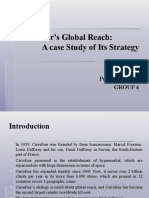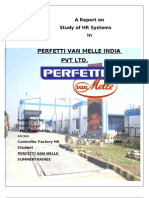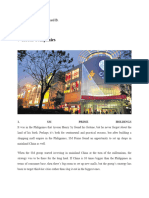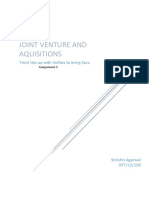0 ratings0% found this document useful (0 votes)
4 viewsIntroduction To International Marketing - 2017 Theory - Company Examples
Introduction To International Marketing - 2017 Theory - Company Examples
Uploaded by
ugc.ecemCopyright:
© All Rights Reserved
Available Formats
Download as PPTX, PDF, TXT or read online from Scribd
Introduction To International Marketing - 2017 Theory - Company Examples
Introduction To International Marketing - 2017 Theory - Company Examples
Uploaded by
ugc.ecem0 ratings0% found this document useful (0 votes)
4 views6 pagesOriginal Title
Introduction to International Marketing _2017 Theory_company Examples
Copyright
© © All Rights Reserved
Available Formats
PPTX, PDF, TXT or read online from Scribd
Share this document
Did you find this document useful?
Is this content inappropriate?
Copyright:
© All Rights Reserved
Available Formats
Download as PPTX, PDF, TXT or read online from Scribd
Download as pptx, pdf, or txt
0 ratings0% found this document useful (0 votes)
4 views6 pagesIntroduction To International Marketing - 2017 Theory - Company Examples
Introduction To International Marketing - 2017 Theory - Company Examples
Uploaded by
ugc.ecemCopyright:
© All Rights Reserved
Available Formats
Download as PPTX, PDF, TXT or read online from Scribd
Download as pptx, pdf, or txt
You are on page 1of 6
ZARA
• Zara was founded by Amancio Ortego, a
former dressgown maker in 1974 in Spain
• Zara’s internationalization practice started
with geographically close markets and the
opening of a store in Oporto (Portugal) in
1988 and France 1990
• Through this establishment Zara acquired
international market experience and
knowledge.
• Zara then expanded further overseas into
international markets that were
geographically more distant but culturally
close such as Mexico in 1992
• It then gradually moved to more distant
countries regardless of cultural and
geographical proximity such as Japan in
1998
• By the end of 2016 Zara was operating in
82 countries with 2,100 stores worldwide
Logitech
• Focusing on the PC mouse, the company was
founded in 1981 by two Italians and a Swiss.
• Operations and R&D were initially split between
California and Switzerland, then expanded rapidly
with production in Ireland and Taiwan.
• By 1989, it’s stylish, innovative and ergonomic
products captured 30 % of the global computer
mouse business, with $140 million in revenues.
• Today, Logitech is an industry leader in the design
and manufacture of computer peripherals
• Has manufacturing facilities in Asia and offices in
North America, Europe, and the Asia-Pacific
region; and over 6,000 people worldwide.
Airbus
• In the 1960s US companies, particularly Boeing and McDonnell-
Douglas, had become the dominant players in the increasingly capital-
intensive airplane industry.
• The smaller European manufacturers competed with one another but
were ineffective against the US rivals
• By the end of the 1960s, the Europeans share of the global aircraft
market was just 10%.
• Then, in 1970, four of the leading European manufacturers – from
France, Germany, Spain and the UK – did something radical and
collaborated rather than compete. They formed the joint venture
Airbus, pooling their resources to design, produce and sell jet aircraft
• Although Airbus’s first customers were European airlines, the venture
began penetrating the American market by 1980 through leveraging
their respective contacts.
• In addition, several pan-European defence collaborations with local
governments allowed it to grow in the 1970s and the cooperation with
governments to develop the Arian defence launcher
• European aircraft manufacturing survived and Airbus had become the
only rival to Boeing.
•
Kerrygold
• 1961 May 17, 1961, An Bord Bainne (The Irish Milk Board) is
established by the Government to “promote, facilitate, encourage,
assist, co-ordinate and develop the exportation of milk and milk
products”.
• Kerrygold is one of their first brands and quickly establishes a strong
foothold in the UK market
• Late 1960s it starts exporting to many more markets overseas, such a
Gibraltar, Malta, Cyprus, Middle East, Gulf States, Canary Islands, the
Caribbean and Asia.
• The Irish Dairy Board becomes Ornua and continues to promote
Kerrygold overseas
• Irish diaspora also help grow the brand around the world seeing the
gold foil is an immediate link to home.
• In 2012, the Irish Dairy Board participates in a trade mission to China.
The Minister for Agriculture, Food and the Marine Simon Coveney,
welcomed the further development of the Kerrygold brand in China - th
key strategic market for Irish dairy exports.
• The brand is now the number 1 butter in Germany and the number 1
Apple
• After first opening retail locations in the US,
foreign buyers started buying in bulk in order to
take them back and sell them to those yearning for
Apple overseas.
• At first, Apple didn't target these international
customers in a strategic way.
• Instead foreign retailers demanded the products
and drove expansion
• Little by little, Apple gradually expanded their
global footprint – with no master plan
• By 2012, 83% of new Apple stores were found in
international locations.
Danone
• Isaac Carasso lived in Barcelona in the 1910s. He observes that
many Spanish children suffer from intestinal infection. Aware of
research into lactic ferments he decides to introduce a product
known in the Balkans for its health benefits: yogurt.
• He launches the Danone brand in 1919 named after his son Daniel,
whose nickname was “Danon”.
• In 1929 Danone opens its first retail store outside Spain in France.
Danone pioneers its message of bringing together enjoyment and
health.
• During the 1970s, Danone acquires many European companies and
in less than 20 years, it becomes Europe’s third largest food
company, leading the market in France, Germany, Belgium, Spain,
Italy, Luxembourg, and Portugal.
• By the mid 1990s, Western Europe accounts for almost 80% of
Danone’s sales.
• With the fall of the Berlin Wall and Communism, Danone further
expands into Eastern Europe, with Asia and Latin America the next
logical targets. Its first major Asian acquisition comes in 1991 with
the purchase of Hong Kong-based Amoy
• The company continues to expand further afield and by 2013, 60% of
its sales come from emerging markets. The company’s new global
equilibrium is the result of geographical diversification. Danone has
You might also like
- Zara PDFDocument85 pagesZara PDFAayush Garg0% (1)
- Nestle Brand Management Case StudyDocument4 pagesNestle Brand Management Case StudySurajit Sarbabidya0% (1)
- Carrefour's Global Reach: A Case Study of Its Strategy: Presented By: Group 4Document8 pagesCarrefour's Global Reach: A Case Study of Its Strategy: Presented By: Group 4Ankit Kumar JhaNo ratings yet
- ZARA PresentationDocument35 pagesZARA PresentationPhilson Nah100% (1)
- ZaraDocument10 pagesZaraNeslisah SaticiNo ratings yet
- Final UniliverDocument56 pagesFinal UniliverZain Mir100% (1)
- Walls Sbu of UnileverDocument25 pagesWalls Sbu of Unilevermaham azizNo ratings yet
- KEY TO CONTROLLED WRITING Powerpoint. HCDHDocument21 pagesKEY TO CONTROLLED WRITING Powerpoint. HCDHTran LeNo ratings yet
- FrenchDocument19 pagesFrenchParth SinghalNo ratings yet
- Presentation On Heineken BeerDocument13 pagesPresentation On Heineken BeerΣόλα ΚαρίμοβαNo ratings yet
- English EssayDocument5 pagesEnglish EssayCristi ŞerbanNo ratings yet
- Business HISTORYDocument6 pagesBusiness HISTORYBalogun DanielNo ratings yet
- Coca-Cola: Global Market Entry Strategies: Abiog, Sofia Aina Chariz Estanda, Chaize Denmar Ilano, Mark EngleDocument5 pagesCoca-Cola: Global Market Entry Strategies: Abiog, Sofia Aina Chariz Estanda, Chaize Denmar Ilano, Mark EngleMark IlanoNo ratings yet
- Coca-Cola: Global Market Entry Strategies: Abiog, Sofia Aina Chariz Estanda, Chaize Denmar Ilano, Mark EngleDocument5 pagesCoca-Cola: Global Market Entry Strategies: Abiog, Sofia Aina Chariz Estanda, Chaize Denmar Ilano, Mark EngleMark IlanoNo ratings yet
- Unilever: Academy of Economic Studies From Bucharest Faculty of International Economic RelationsDocument15 pagesUnilever: Academy of Economic Studies From Bucharest Faculty of International Economic RelationsCatalina BericovNo ratings yet
- Dajana Vranić 198/11 Jovana Joksimović 214/07 Milena Pavlićević 421/08Document13 pagesDajana Vranić 198/11 Jovana Joksimović 214/07 Milena Pavlićević 421/08DajanaNo ratings yet
- Multinational Company ProfileDocument9 pagesMultinational Company Profilesalem_minhNo ratings yet
- Cleaning Agents Personal Care Products Food Spreads MargarineDocument2 pagesCleaning Agents Personal Care Products Food Spreads MargarineHien NguyenNo ratings yet
- HR System at PerfettiDocument100 pagesHR System at PerfettiAshutosh SinghNo ratings yet
- Nestle's Brand Management StrategiesDocument4 pagesNestle's Brand Management StrategiesAli Ahmed100% (1)
- Unilever ProfileDocument33 pagesUnilever ProfileAnslem TayNo ratings yet
- Part 2 Financial Statement AnalysisDocument8 pagesPart 2 Financial Statement AnalysisJhiya Cristina UyNo ratings yet
- COLGATE HistoryDocument2 pagesCOLGATE HistoryHariom MhatreNo ratings yet
- Case 1: Unilever Ice Cream Defends Its Global Market ShareDocument3 pagesCase 1: Unilever Ice Cream Defends Its Global Market ShareShruti TiwariNo ratings yet
- Chap1 - We Live in A Global EconomyDocument9 pagesChap1 - We Live in A Global EconomyLysss EpssssNo ratings yet
- Unilever Lux: MissionDocument13 pagesUnilever Lux: MissionshaiziqNo ratings yet
- Histories of Different BrandsDocument5 pagesHistories of Different BrandsnaumanayubiNo ratings yet
- NestleDocument5 pagesNestlerazi87No ratings yet
- Zara PresentationDocument26 pagesZara PresentationAmnasamina100% (1)
- NestleDocument69 pagesNestlejazz567No ratings yet
- UniliverDocument44 pagesUniliverAhtisham AhsanNo ratings yet
- Case Study - NestleDocument9 pagesCase Study - NestleVijay BhatiNo ratings yet
- Module1 - We Live in A Global EconomyDocument9 pagesModule1 - We Live in A Global EconomyAnthony DyNo ratings yet
- The 3M Inter NationalizationDocument15 pagesThe 3M Inter NationalizationsarahlataniaNo ratings yet
- Zara Exposicion BuenaDocument4 pagesZara Exposicion Buena798817No ratings yet
- Presentation MainDocument13 pagesPresentation MainMDNo ratings yet
- Assignment - Mjartanova - H&M and Further Innovation (Change Management)Document17 pagesAssignment - Mjartanova - H&M and Further Innovation (Change Management)Cheizer ArantesNo ratings yet
- Distribution Systems Subject Teacher: Preeti MamDocument21 pagesDistribution Systems Subject Teacher: Preeti MamDigambar LohakareNo ratings yet
- Nestle HistoryDocument85 pagesNestle HistoryAamir Raza100% (16)
- Company Profile: International MarketingDocument8 pagesCompany Profile: International Marketingvickyzheng_1No ratings yet
- MKTG Plan in Sunsilk PhilippinesDocument55 pagesMKTG Plan in Sunsilk Philippinesshankadash50% (2)
- Basilan John Deil 7companiesDocument12 pagesBasilan John Deil 7companiessoftware appNo ratings yet
- Unilever Promotional MixDocument18 pagesUnilever Promotional MixSyed Salman Abbas69% (13)
- Ownership Bauer Media: Ned Viehoff Fact Sheet Unit 1Document2 pagesOwnership Bauer Media: Ned Viehoff Fact Sheet Unit 1Ned ViehoffNo ratings yet
- History of Nestle EditedDocument10 pagesHistory of Nestle EditedgeralyncNo ratings yet
- GM Group Report PDFDocument38 pagesGM Group Report PDFKevinSimonNo ratings yet
- AExopsé Haribo DiagnosticDocument15 pagesAExopsé Haribo DiagnosticValentin OrfeuvreNo ratings yet
- Point Wise ZaraDocument22 pagesPoint Wise ZaraDibyendu RoyNo ratings yet
- United Colors of BenettonDocument11 pagesUnited Colors of BenettonRAHUL16398No ratings yet
- Nestle ReportDocument25 pagesNestle Reportdhaval_is_hereNo ratings yet
- Colgate Marketing ReportDocument16 pagesColgate Marketing ReportRaja GuruNo ratings yet
- ArcorDocument2 pagesArcormelissaNo ratings yet
- UCB & LEVIsDocument26 pagesUCB & LEVIsKhyati DhabaliaNo ratings yet
- GE 6102 Prelim ILP FrancisDocument8 pagesGE 6102 Prelim ILP FrancisKurogamiNo ratings yet
- IKEA: How to Become the World's Richest ManFrom EverandIKEA: How to Become the World's Richest ManRating: 3.5 out of 5 stars3.5/5 (11)
- Summary of Yvon Chouinard and Naomi Klein's Let My People Go SurfingFrom EverandSummary of Yvon Chouinard and Naomi Klein's Let My People Go SurfingNo ratings yet
- Apples, Insights and Mad Inventors: An Entertaining Analysis of Modern MarketingFrom EverandApples, Insights and Mad Inventors: An Entertaining Analysis of Modern MarketingRating: 5 out of 5 stars5/5 (2)
- Pestel Analysis of ZaraDocument3 pagesPestel Analysis of ZaraZain AliNo ratings yet
- GSCM-Global Sourcing-Li and Fung - ZaraDocument51 pagesGSCM-Global Sourcing-Li and Fung - ZaraakhilNo ratings yet
- Global Fashion Brands Exploiting Bangladesh Workers StudyDocument7 pagesGlobal Fashion Brands Exploiting Bangladesh Workers Studyjo lamosNo ratings yet
- So, The 1 Slide Is About That Why We Choose ZaraDocument3 pagesSo, The 1 Slide Is About That Why We Choose ZaraAbhishek BidhanNo ratings yet
- Integrated Business ModelDocument4 pagesIntegrated Business ModelAlexandra GonçalvesNo ratings yet
- SCM - CH1 Understanding SCDocument38 pagesSCM - CH1 Understanding SCMrunal ShethNo ratings yet
- Internationalisation of The Spanish Fashion Brand Zara: Case StudyDocument18 pagesInternationalisation of The Spanish Fashion Brand Zara: Case StudyAsia CelińskaNo ratings yet
- Zara International: Fashion at Speed of LightDocument16 pagesZara International: Fashion at Speed of LightRITIKA DHOOTNo ratings yet
- Minor Project Ipshita JalalDocument65 pagesMinor Project Ipshita Jalalmirajpandey599No ratings yet
- Essay Writing: Moving ForwardDocument15 pagesEssay Writing: Moving ForwardAlvaro Emmanuel AcostaNo ratings yet
- Zara Project Report Part 02Document23 pagesZara Project Report Part 02adeel0523261No ratings yet
- ZaraDocument4 pagesZarapiqoni100% (3)
- Zara Fast Fashion Case AnalysisDocument3 pagesZara Fast Fashion Case AnalysisVivek Vishal40% (5)
- International Bus Case Study Chap 12Document2 pagesInternational Bus Case Study Chap 12Sierra Marie SiwaNo ratings yet
- Supply Chain Management of ZARADocument18 pagesSupply Chain Management of ZARABalaji AsokanNo ratings yet
- Joint Venture Between Tata and ZaraDocument4 pagesJoint Venture Between Tata and ZaraShrishti Agarwal100% (1)
- Gartner Top 25 Supply Chain 2017Document30 pagesGartner Top 25 Supply Chain 2017KhảVyNo ratings yet
- ch1 SCM PDFDocument68 pagesch1 SCM PDFTarun KumarNo ratings yet
- Sorting Responsible Business Practices in Fast Fashion: A Case Study of ZaraDocument5 pagesSorting Responsible Business Practices in Fast Fashion: A Case Study of ZaraSrirang JhaNo ratings yet
- Unit 4-Intro To Services MKTG - Price - Place - Jessy Nair - PESU - JN-MinorsDocument109 pagesUnit 4-Intro To Services MKTG - Price - Place - Jessy Nair - PESU - JN-MinorsJaya HarshitNo ratings yet
- ZaraDocument11 pagesZarasunnyNo ratings yet
- Topic: Brand Loyalty of Customers in Zara BrandDocument82 pagesTopic: Brand Loyalty of Customers in Zara Brandsuhani jainNo ratings yet
- Zara PPT - Group9Document16 pagesZara PPT - Group9Snehashis KhanNo ratings yet
- Zara CSR and Sustainability AnalysisDocument13 pagesZara CSR and Sustainability AnalysisMirza Yuliana PratiwiNo ratings yet
- ZaraDocument12 pagesZaraMUHAMMAD HASHIMNo ratings yet
- On Zara PPT 6Document1 pageOn Zara PPT 6LuysNo ratings yet
- Customer Journey Zara Assignment FinalDocument21 pagesCustomer Journey Zara Assignment FinalNguyễn PhươngNo ratings yet

























































































